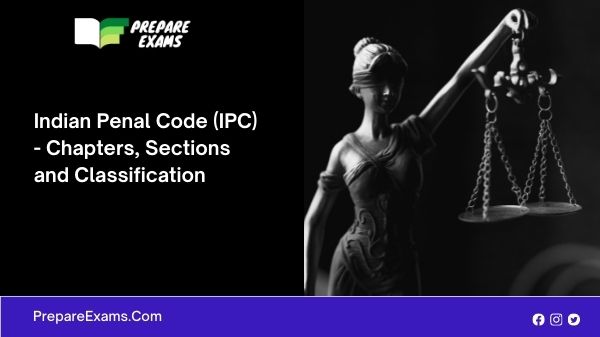Indian Penal Code (IPC) – Chapters, Sections and Classification – The Indian Penal Code (IPC) is the official criminal code of India and is a comprehensive code that covers all substantive aspects of criminal law. The code was drafted on the recommendations of the first law commission of India established in 1834 under the Charter Act of 1833 under the chairmanship of Thomas Babington Macaulay. In 1862, It came into force in British India during the early British Raj period.
Indian Penal Code: History
- In 1834, The draft of the Indian Penal Code was prepared by the First Law Commission, chaired by Thomas Babington Macaulay.
- In 1835, It was submitted to the Governor-General of India Council.
- In 1837, The first final draft of the Indian Penal Code was submitted to the Governor-General of India in Council.
- In 1850, The drafting was completed and the Code was presented to the Legislative Council in 1856.
- It was passed into law on 6 October 1860 and came into operation on 1 January 1862.
Indian Penal Code, 1860 (Sections 1 to 511)
| Chapter | Sections | Classification of offences |
| Chapter I | Sections 1 to 5 | Introduction |
| Chapter II | Sections 6 to 52 | General Explanations |
| Chapter III | Sections 53 to 75 | Of Punishments |
| Chapter IV | Sections 76 to 106 | General Exceptions of the Right of Private Defence (Sections 96 to 106) |
| Chapter V | Sections 107 to 120 | Of Abetment |
| Chapter VA | Sections 120A to 120B | Criminal Conspiracy |
| Chapter VI | Sections 121 to 130 | Of offences against the state |
| Chapter VII | Sections 131 to 140 | Of Offences relating to the Army, Navy, and Air Force |
| Chapter VIII | Sections 141 to 160 | Of Offences against the Public Tranquility |
| Chapter IX | Sections 161 to 171 | Of Offences by or relating to Public Servants |
| Chapter IXA | Sections 171A to 171I | Of Offences Relating to Elections |
| Chapter X | Sections 172 to 190 | Of Contempts of Lawful; Authority of Public Servants |
| Chapter XI | Sections 191 to 229 | Of False Evidence and Offence against Public Justice |
| Chapter XII | Sections 230 to 263 | Of Offences relating to coin and Government Stamps |
| Chapter XIII | Sections 264 to 267 | Of Offences relating to Weight and Measures |
| Chapter XIV | Sections 268 to 294 | Of offences affecting the Public Health, Safety, Convenience, Decency and Morals |
| Chapter XV | Sections 295 to 298 | Of Offences relating to religion |
| Chapter XVI | Sections 299 to 377 | Of Offences affecting the Human Body. Of Offences Affecting Life including murder, culpable homicide (Sections 299 to 311) Of the Causing of Miscarriage, of Injuries to Unborn Children, of the Exposure of Infants, and of the Concealment of Births (Sections 312 to 318) Of Hurt (Sections 319 to 338) Of Wrongful Restraint and Wrongful Confinement (Sections 339 to 348) Of Criminal Force and Assault (Sections 349 to 358) Of Kidnapping, Abduction, Slavery and Forced Labour (Sections 359 to 374) Sexual Offences including rape and Sodomy (Sections 375 to 377) |
| Chapter XVII | Sections 378 to 462 | Of Offences Against PropertyOf Theft (Sections 378 to 382) Of Extortion (Sections 383 to 389) Of Robbery and Dacoity (Sections 390 to 402) Of Criminal Misappropriation of Property (Sections 403 to 404) Of Criminal Breach of Trust (Sections 405 to 409) Of the Receiving of Stolen Property (Sections 410 to 414) Of Cheating (Section 415 to 420) Of Fraudulent Deeds and Disposition of Property (Sections 421 to 424) Of Mischief (Sections 425 to 440) Of Criminal Trespass (Sections 441 to 462) |
| Chapter XVIII | Section 463 to 489 – E | Offences relating to Documents and Property Marks Offences relating to Documents (Section 463 to 477-A) Offences relating to Property and Other Marks (Sections 478 to 489) Offences relating to Currency Notes and Bank Notes (Sections 489A to 489E) |
| Chapter XIX | Sections 490 to 492 | Of the Criminal Breach of Contracts of Service |
| Chapter XX | Sections 493 to 498 | Of Offences Relating to Marriage |
| Chapter XXA | Sections 498A | Of Cruelty by Husband or Relatives of Husband |
| Chapter XXI | Sections 499 to 502 | Of Defamation |
| Chapter XXII | Sections 503 to 510 | Of Criminal intimidation, Insult and Annoyance |
| Chapter XXIII | Section 511 | Of Attempts to Commit Offences |
Indian Penal Code: Frequently Asked Questions
What does IPC stand for?
IPC stands for Indian penal code.
Who made the Indian Penal Code?
The chairman of the first law commission Thomas Babington Macaulay drafted the Indian penal code. The draft was completed by 1834 and was presented to the Governor-General of India in 1835.
Who is the Father of Indian Modern Legal Education?
Dr Neelakanta Ramakrishna Madhava Menon is known as the Father of Indian Modern Legal Education.
When did the Indian penal code come into force?
The Indian penal code came into force on the 1st of January 1860 after many revisions and amendments.
What are the sections of the Indian penal code?
The Indian Penal Code of 1860, sub-divided into 23 chapters, comprises 511 sections.
★★★★ You Can Also Read ★★★★
| Computer Awareness Quiz Questions Set (Banking) |
| Read Daily Current Affairs Topic Wise |
| Daily Current Affairs Quiz (Current GK Test) |
| Static Gk Quiz Questions and Answers |
📣 Prepare Exams is now on Facebook, Twitter, Instagram, YouTube Channel, and Google News to get all the latest News first Like, Follow and bookmark our website @ PrepareExams.com.
For all the latest Updates, download PrepareExams App.


